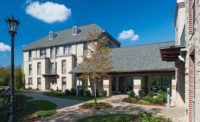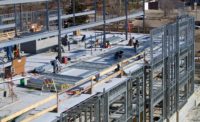In a competitive market environment, I believe in aggressive promotion and a robust defense of the industry I represent. At the same time, I don’t think it’s in the best long-term interest of the industry to use objectively false statements to promote an industry or product, like the ever-popular fable, “wood doesn’t burn, it chars.”
That’s why I was astounded by a claim attributed to the Climate Trust that “a piece of land with no building on it has a higher carbon footprint than a piece of land with a CLT [cross-laminated timber] building.” To that, add the recent statements made by various wood-friendly architects that “the widespread adoption and growth of CLT (cross-laminated timber) quite literally has the potential to save the planet.”
Really? Let’s take a deep breath, folks.
Cross-laminated timber is the wood industry’s latest effort to push a combustible construction material into the nonresidential building market using their incredibly deep pockets (which, incidentally, is partially filled by your taxes and mine). And I predict we’ll all be hearing a lot more about how the use of mass timber products like CLT has the power to reverse climate change.
This is because focusing on sustainability helps shift attention away from some real issues that inhibit the kind of widespread market adoption that is needed for the wood industry to justify the enormous amount of resources it’s throwing at this product.
The Issues
First issue on this list is fire and the fear factor. The public intuitively understands the connection between fire and combustible construction materials, a fact that the recent record of major fires in mid-rise wood framed buildings has done little to allay.
“Cost” is the second major barrier. CLT buildings are relatively rare in North America, so there’s a very limited amount of actual data that’s available to support wood industry claims that it is cost-competitive with other construction products. In reality, there are a lot of big and small expenses that can and will add up. For example, if the construction site is not near a CLT production facility or a forest that can supply the timber then expect the transportation costs to be sky high. Also, little things like the lack of wall cavities for electrical and plumbing runs require special solutions and installation techniques. Additional fire protection will cost $2 to $6 per square foot, and so on.
If CLT was truly cost competitive as advertised, then why is the wood industry subsidizing the development of projects through competitions that award $500,000 grants for CLT building designs?
With these issues still to contend with, it’s not really surprising that the pages in the wood industry songbook are turning to “sustainability” and promoting the concept that increased use of cross-laminated timber can reverse climate change effects at a large scale.
Call me a skeptic. You should be, too.
LCA Studies
The wood industry has invested tens of millions of dollars over the past 25 years to generate dozens of reports and lifecycle assessment studies that define and defend the “green” credentials of wood. However, it’s not much of a secret that a lifecycle assessment (LCA) study can be manipulated in ways that will consistently produce the desired outcome simply by choosing the “right” methodology, selectively applying boundaries to the study, establishing the basis of comparison, and limiting the scope of the study.
Here is what you need to know about the LCA studies on wood products:
Not every LCA study applies the same assumptions or follows the same process. The wood industry typically uses a method called “attributional” that takes a credit based on environmental impacts in current terms. However, if the wood industry is promoting increased use of their product then it should use the alternative method, called “consequential” to account for changes to the entire list of environmental impacts.
Not all forests are sustainably managed. The environmental impact studies published by the wood industry are based on the assumption that the wood comes from a sustainably managed forest. While forest certification is generally growing, wood industry statistics report that less than 10 percent of forests in the U.S. are certified as being managed sustainably. This would seem to invalidate many of the LCA studies by the wood industry as the results would only truly apply to a small share of wood construction products available to the market today.
Not all wood is the same. There are literally hundreds of tree species in the United States, each of which will exhibit different carbon sequestration rates and behavior, yet the type of wood selected for an LCA study is rarely identified. Similarly, an LCA study on CLT panels should recognize that it’s not the same product as a dimensioned lumber and should include environmental impacts from the significant quantities of adhesives required to hold the panels together.
Not all environmental impacts are included in the boundaries set for an LCA study on wood products. Unlike other materials, LCA studies are considered “cradle to grave” with a distinct end of life. This does not provide an accurate analysis of the full environmental impacts to account for planting and land management, transportation generated during forest management, harvesting, mill emissions, transportation to regional distributors and consumers, end of life deconstruction, and disposal or incineration of waste.
Questions to Ask
What about the other impacts? Glowing claims about CLT are usually in reference to a study or report on CO₂ emissions but perhaps there’s more we should consider. For example, harvesting destroys habitats and not all species that once lived in the old forest can be supported in the lack of diversity in the replanted forests.
Will cross-laminated timber save the planet? I’m not so sure. And certainly not without the contributions of other materials like infinitely recyclable steel.
However, regardless of what I think about the sustainability claims of wood, it would be a mistake to dismiss CLT as a market share threat to companies that make the steel, the steel framing and accessories, the tools and equipment, design and build with cold-formed steel. While not cost-competitive today, there’s a lot of money and effort being put into developing solutions, creating manufacturing capacity, recruiting architects, promoting awareness, and changing building codes.
Our challenge is to continue ensuring that we’re keeping our eyes on the ball that matters: giving our customers high quality, cost-effective, innovative and aesthetically pleasing solutions.








Report Abusive Comment